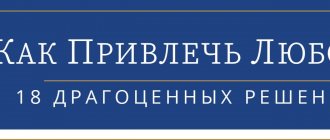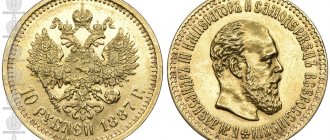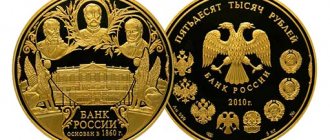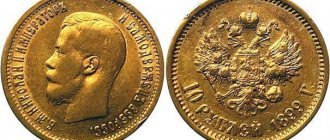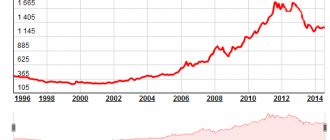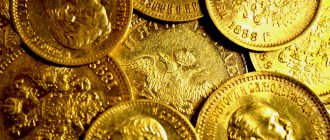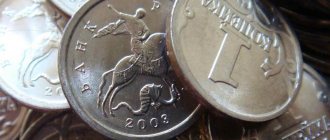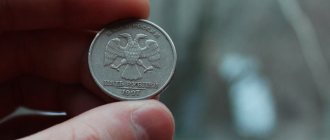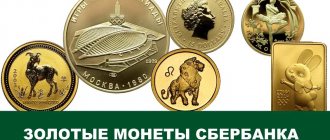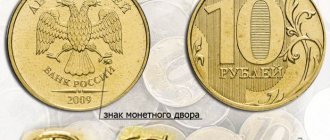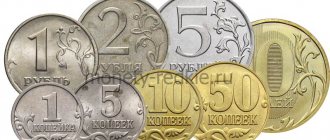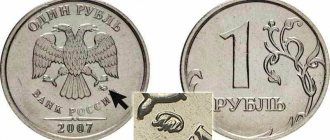Hello, dear reader. Coins of Nicholas 2 are valued among collectors and investors from all over the world. During the time of the last Russian emperor, money was minted in large quantities, but in everyday life it did not last long. They are well preserved and quite common, which explains the increased demand. At the same time, collectors call the royal rubles and half rubles the most tasty morsel.
The smallest denominations of 1894
Nicholas II became Emperor of All Russia in October 1894. The first all-Russian coins with his portrait from 25 kopecks to imperial (10 rubles in gold) will appear only next year. Making a portrait, approving it and transferring it to coins is a slow process. Denominations from a penny to two hryvnia do not need any changes. A different matter is the faction of the kopeck, on the obverse of which, according to tradition, the monogram of the ruling sovereign is minted. Here the St. Petersburg Mint managed to show dexterity and cut out new stamps with a stylized letter “N”. But very few coins with the date “1894” were minted. Let's look into the book by V.V. Uzdenikov “Volume of minting of Russian coins.” From it you can find out that the circulation of the quarter penny was only 2,000 pieces. Information about the number of half-kopeck coins is unknown, but it is unlikely that there were much more. Therefore, the price of each of these coins has been kept at the level of one hundred thousand rubles for a long time.
Coins of the era of Nicholas 2 in silver
Banknotes from 5 kopecks to 1 ruble were minted in this metal.
- Pyatak. Produced in 1897–1906 and from 1908 to 1915. The appearance has not changed all this time. The weight of one copy is 0.9 grams.
- Dime. Manufactured in 1895–1917. Sample Ag - 500. Sample weight - 1.8 g. On the obverse under the coat of arms are the initials of a mint official (minimaster), except for copies of 1916, since they were minted in Japan, there are no additional designations on them.
- 15 k. Years of manufacture: 1896–1909, 1911–1917. Several batches were also produced in Osaka and were not stamped with the minitzmeiter's initials.
- 20 k. Issue period 1867–1917. Until 1915, samples had a mint mark. And they all bear the sign of the official supervising the party.
- 25 k. Produced from 1895 to 1901, except for 1897 and 1899.
- Half a ruble. Minted between 1896–1899. (except 1905) not only in Russia, but also abroad. On such specimens, instead of the minimaster’s initials, there are stars and birds on the edge.
- Ruble. Manufactured from 1895 to 1915. It also has several appearance options, differing in edge. There are also examples of foreign coinage, marked with a tick, one or a pair of stars.
Polushka 1895
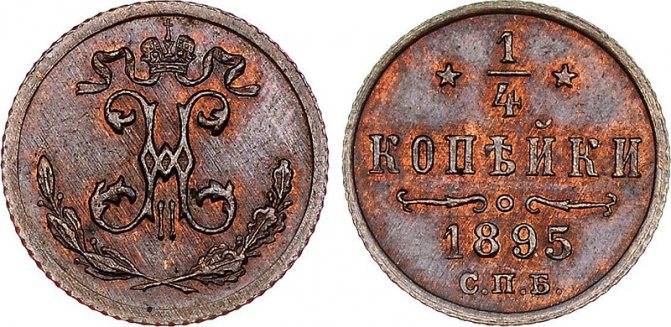
With a mintage of 60,000 copies, this coin was initially destined to be one of the most sought after items by collectors. Why is the output volume so small? The reason lies in the fact that during Witte’s monetary reform, priority was given to gold and silver denominations. There are no resources or production capacity left for copper. That is why the entire issue of all-Russian copper coins from 1896 to 1898 was transferred abroad to the Birmingham Mint, and in 1899-1901. The Rosenkrantz plant is engaged in minting denominations in copper.
How much is the silver coin Nicholas 2 worth?
| Denomination | Production year | Price in rubles* |
| Pyatak | 1897–1905, 1907–1909, 19011-1915 | 500–800 |
| 1906 | 1800 | |
| 1910 | 1200 | |
| Dime | 1898–1916 | 150–250 |
| 1895 | 3 000 | |
| 1896–1897 | 1 000 | |
| 1916 (Osaka) | 1500 | |
| 1917 | 5000 | |
| 15 kopecks | 1899–1916 | 200–250 |
| 1896 | 10 000 | |
| 1897–1898,1916 | 1 000–1 500 | |
| 1917 | 6 000 | |
| 20 k. | 1901–1916 | 250–800 |
| 1917 | 35 000 | |
| 25 k. | 1895–1896 | 1 200-3 000 |
| 1900 | 4 500 | |
| 1901 | 45 000 | |
| 50 k. | 1895–1897, 1899–1901, 1910–1914 | 400 |
| 1898 | 100 000 | |
| 1902, 1908–1914 | 700-1 500 | |
| 1903 | 5 000–9 000 | |
| 1 ruble | 1895–1901 | 700 |
| 1902–1903, 1906–1915 | 3 000–5 000 | |
| 1904–1905 | 10 000–12 000 |
*The table shows the initial auction price for valuable coins of Nicholas 2. The price range can be tenfold or higher.
For example, for 20 silver kopecks you can get 2,500 rubles. (according to the catalogue, it starts from 250 rubles)
Variety “3 curls”
Almost three million half-kopeck coins with the date “1895” were issued. Therefore, only specimens that are marked in the auction descriptions as “monogram of a special design, three curls at the top” are of interest. What's wrong with the monogram? After all, on the coins discussed above, the monogram still has the same three curls. Yes, for a quarter penny this is a standard design, but on a half penny the monogram should have four curls (as on the coin on the right), and not three (as on the coin on the left). The diameter of the smaller denomination is 13.2 mm, while the other is more than 16 in diameter. On the obverse we do not see a double or wide edge, therefore, we do not have a “mix-up” on the obverse. This was probably an engraver's error, which was discovered after the minting process had started.
Copper 1902
The year 1902 is notable for domestic numismatics, among other things, because the St. Petersburg Mint resumes minting national copper coins in denominations of one, two and three kopecks. If you look at the old price tags, you will be amazed at how much higher the cost of this three is indicated there compared to similar denominations of subsequent years. The reasons were sought in the circulation, which for each denomination is either the smallest of the mass ones, or is close in value to the smallest. But the metal detector era added many 1902 copper coins to the market, so their price leveled off with neighboring years. However, in excellent and exceptional preservation, copper with the date “1902” remains very popular and expensive.
Polushka 1915
In 1915, the St. Petersburg Mint minted half a million quarters. This number cannot be called immeasurably small, but not many copies have survived to this day. This fact creates difficulty for those who set the goal of collecting all the mass-produced copper coins of Nicholas II. Therefore, to close a position, you will have to part with several thousand, or even tens of thousands of rubles. The abbreviation “S.P.B.” is missing on the reverse. With the outbreak of World War I, the mass extermination of everything German began. Even St. Petersburg is being renamed Petrograd. Therefore, the mint designation was stopped.
Anniversary and commemorative coins
In 1912, the mint issued commemorative coins commemorating the 100th anniversary of the victory over Napoleon and the 300th anniversary of the reign of the House of Romanov.
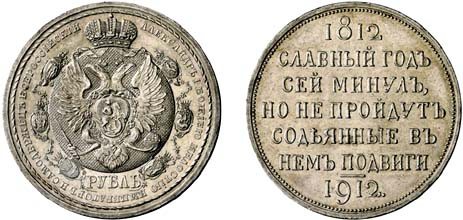
Of particular value are: the Gangut ruble , this is the last commemorative coin minted in the Russian Empire
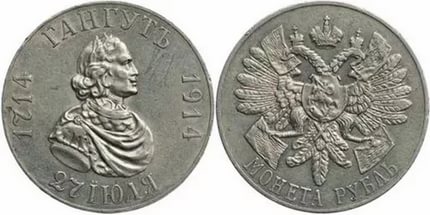
The smallest denominations of 1916
Here, it would seem, the circulations are not so small: 9,400,000 pieces for a half penny and 1,200,000 pieces for a quarter. But this amount turns out to be a drop in the bucket when the country is experiencing severe monetary shortages. The government is forced to order a gigantic circulation of ten-kopeck and five-altyn coins from Japan, and launch paper stamp money within the country. The silver coin has already disappeared from circulation, and the copper coin is also beginning to be hidden, based on the experience of previous generations, who remember that the exchange rate of the ruble in paper and in coin can differ significantly.
Pyatak 1916
In the same year, a nickel was minted, which is considered the rarest of this denomination in copper from the period of Nicholas II. Since 1882, the five-kopeck piece has been found exclusively among low-grade silver, and only in 1911 and 1912. The release of this denomination in copper is launched. By 1916, Russia was determined to return 5 kopecks to the line of copper coins, as evidenced by the 1916 trial 5 kopecks, which you will see below. Despite the fact that the circulation of an ordinary copper nickel was eight million, collectors value it more than coins with the dates “1911” and “1912”.
The rarest and most expensive silver coins
The silver ruble under Nicholas II was minted in large quantities. But examples of this denomination, issued in 1987 and 1989, received special value after hallmarking in 1917. Today, a silver ruble with the mark “Dethronement of the House of Romanov” is considered one of the most expensive and rare.
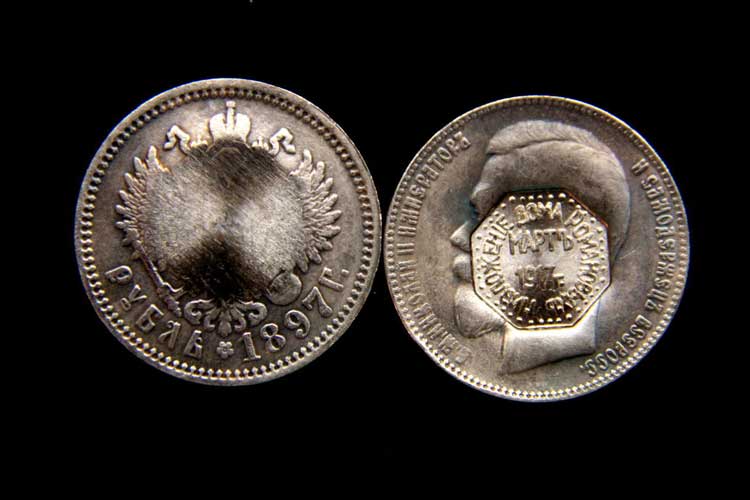
Uniques of 1917
Silver coins from 1917, although rare, are constantly present on the numismatic market. But the same cannot be said about copper coins. Moreover, even the experts in numismatics can tell little about this mysterious issue. Most likely, we are talking about test coins that are made before mass minting, but they did not have time to launch it, since the country found itself in a new reality, and small money was already losing all purchasing power. The Russian Museum stores the 1 and 5 kopecks shown above from 1917, which are technological samples. Unlike experimental samples, such coins fully correspond to circulation coins. In addition to this pair, there is another known nickel that is known to be genuine and is in a private collection. The remaining specimens, illuminated in different places, raise questions. And for good reason!
Here is a penny with the date “1917”, sold on the Teutoburger Münzauktion site in February 2021 for 725 euros (an extremely low price for a rarity). But a glance at the seven date will immediately reveal differences from the same number on the technological sample stored in the museum. Therefore, the size of the amount paid immediately ceases to surprise. However, the story with copper in 1917 is far from over. In the museum at the St. Petersburg Mint, to the great surprise of numismatists, stamps of the complete set (1/2, 1, 2, 3 and 5 kopecks) for copper from 1917 were exhibited. That is, theoretically, if there is a ready-made tool, new models may appear.
Kinds
In total, the legacy of the last of the Romanovs amounts to several tens of rubles and kopecks of various denominations, which can be divided into three main groups: gold, silver and copper. Coins of Nicholas II can be divided into several groups according to the year of issue. Gold and silver copies were constantly undergoing changes. Depending on the time of minting, the image of the emperor was smoother or more convex.
Gold
After the reform carried out by the Minister of Finance of Nicholas II Witte and the transition to the “Gold Standard” in 1897, unusual banknotes in denominations of 15 and 7.5 rubles appeared - the so-called semi-imperials. They were minted, like chervonets or nickels, from 900-karat gold. And items made of such high-grade precious metal can be sold profitably at any time.
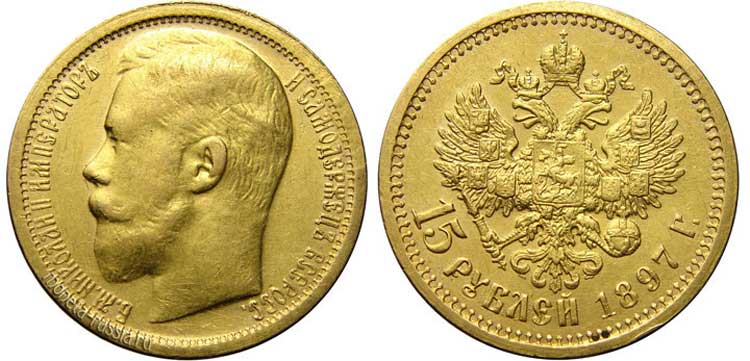
Money with a face value of 15 rubles has two characteristic features. On copies released earlier, two letters extend beyond the neck trim; in later issues, three. Tsar's chervonets and gold five-ruble coins of Nicholas II (a third of the imperial coin) were often found in everyday use. The Tsar's chervonets were issued over a period of 13 years, from 1898 to 1911, and are presented in 4 series. During the entire period of minting, chervonets and five-ruble coins remained virtually unchanged. Their obverse is decorated with the imperial profile, and the reverse is decorated with the Russian coat of arms.
Silver
They were minted from 900 silver in denominations of 5, 10, 15, 20, 25 and 50 kopecks. The largest silver coin was the Nicholas ruble, which over the 20 years of issue bore 5 different images of Emperor Nicholas II on its obverse. The most prominent are the images minted on copies of 1912-13. The eagle's shape remained more or less stable.
After the ruble began to lose its value, silver fifty rubles became very popular and were reissued approximately 19 times. The portrait of the emperor on the obverse of the 50-kopeck coin underwent changes 5 times. The most noteworthy are the 1914 specimens with the flat profile of Nicholas II and the Parisian minted specimens (1896-1899), the edge of which is decorated with a star.
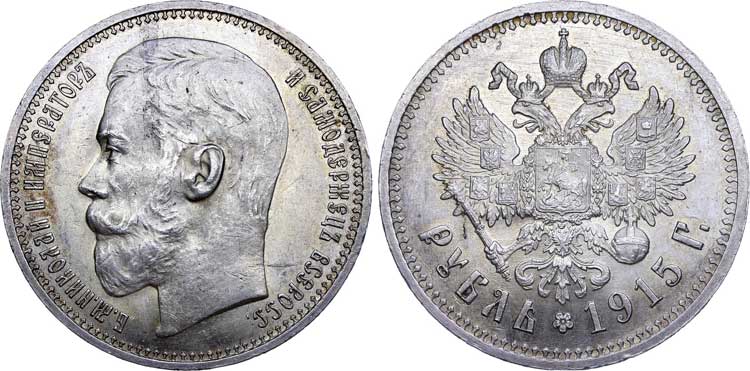
With the depreciation of the ruble, 25 kopecks lose their importance, and after 1896 their issue ceases. During its history, the half-fifty coins changed the portrait of Nicholas II three times.
The edge of all specimens, regardless of the year of manufacture, has a jagged shape.
The small denomination - 5 kopecks - was no longer issued after 1915. In 1916, coins of Nicholas II with a value of 10 and 15 kopecks were minted not in St. Petersburg (like the previous series), but in Japan. This year's pieces are distinguished by the absence of a mint mark. The mintzmeister's initials are also not indicated under the eagle.
Copper
Copper coins were minted in denominations of ¼, ½, 1, 2, 3 and 5 kopecks. Due to the heavy workload of the mint with work on gold coinage, the production of copper kopecks (except for the nickel) is transferred to Birmingham. And in the period from 1899 to 1901, copper was minted by the St. Petersburg Rosenkrantz plant.
With the coming to power of Nicholas II, the bulk of copper kopecks did not change. The imperial monogram received a new look only on small coins: money and half coins.
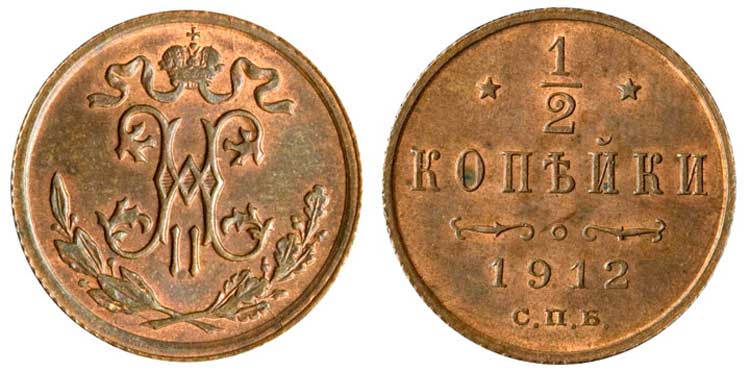
Was the 1907 penny gold?
Let's give an example of how the most ordinary coin can be rare and valuable. But for an extremely short time. A kind of “fakir for an hour”. Above is a clipping from the pre-revolutionary newspaper “Old Coin”. It is not known how great the public excitement was in the hope of getting forty denominations for the coin. Perhaps the trend has spread to the broad masses, just as relatively recently the people of modern Russia throughout the country were looking for “five thousand under the paw of an eagle” - 1, 2 and 5 rubles of 2003, through the shares of a commercial bank. Of course, no gold was found in the 1907 kopecks. But a coin with a circulation of twenty million cannot be rare. However, the specimen in the lower right corner of the illustration costs more than a penny in pure gold, although it is made of copper. In April 2013, it was purchased for $1,763. What's the secret?
Proof quality coins
The answer lies in production technology. A tiny part of the mintage of most of the coins of Nicholas II was minted not using the usual technology, but in a polished coinage - the forerunner of the modern “Proof”. The design was applied to the polished blanks with specially prepared stamps, which is why the field received a mirror surface and the relief became matte. Having a collection of everyday coins in polished mintage is a special chic. Therefore, given the small quantity, the demand for such specimens is incredibly high. Any coin of Nicholas II (including copper) is rare and valuable if it is issued in a polished mint. Here are just a few examples recorded in our catalog:
- 2 kopecks 1895 “Proof” - 128,125 ₽
- 3 kopecks 1895 “Proof” - 104,000 ₽
- 2 kopecks 1899 “Proof” – $2,585
- 3 kopecks 1904 “Proof” - 95,000 ₽
- 3 kopecks 1908 “Proof” – $4,259
- 1 kopeck 1913 “Proof” – $2,350
- 3 kopecks 1914 “Proof” - 105,000 ₽
And these are also those positions for which ordinary minted coins are not included in the category of rare ones.
Coins of Nicholas II Alexandrovich (1894-1917)
The reign of Nicholas II went down in history as a very turbulent period. The revolutionary movements that originated under Alexander III gained strength until they led to the Revolution of 1905. This time the uprising was suppressed. To avoid new unrest, several reforms were adopted regarding freedom of religion, freedom of speech and the establishment of the State Duma. But all this only contributed to the strengthening of popular movements. In 1914, new interstate alliances led to Russia's entry into the First World War. The opposition took advantage of the weakening of the economy and power, and at the beginning of 1917 the February Revolution took place, during which Nicholas II abdicated the throne. In March, the Provisional Government came to power. A year and a half later, in July 1918, the emperor was shot in Yekaterinburg along with his family. There were also many changes in the coinage of this time. In 1895-1898, a monetary reform was carried out under the leadership of S.Yu. Witte, during which the gold ruble became the basis of monetary circulation (before that, silver was considered the main one). The weight of gold coins is reduced by one and a half times. In 1897, coins of the old weight were minted for the last time, but with an increased denomination (15 and 7.5 rubles). In 1915-1916, due to the difficult economic situation, it was planned to introduce lightweight copper-nickel coins in denominations from 3 to 25 kopecks; lower denominations were to remain copper, but one and a half times lighter. The issue of introducing steel money was even considered. All developed versions remained trial ones and are now highly valued among collectors.
15 and 7.5 rubles
Monetary reform S.Yu. Witte meant reducing the weight of gold coins by one and a half times. Experiments with the development of new monetary units (imperial and rus) were not successful; the imperial remained a counting concept equal to 15, and not 10 rubles as before. To simplify calculations and prepare the population for the new money, in 1897, coins of non-standard denominations of 15 and 7.5 rubles were issued in multi-million circulations. 15 rubles has two varieties, differing in the displacement of the inscription relative to the portrait.
10 rubles
Perhaps the most famous gold coin of the Russian Empire, with a portrait of Nicholas II and a coat of arms on the reverse side with a face value of 10 rubles, became one of the symbols of autocracy. A huge number of them were issued, so these coins became the main item for treasures from the Civil War. It was minted annually from 1898 to 1904, then in 1906, 1909, 1910 and 1911. According to unofficial information, they could have been produced in the 1920s for international payments.
5 rubles
Gold 5 rubles with a portrait of Nicholas II and a double-headed eagle were minted from 1898 to 1911, except for 1905 and 1908. The 1907 coins are of great value due to a very limited mintage (a little over 100 pieces). There is a pattern on the edge, with the exception of some issues with a smooth edge. The neck trim contains the engraver's initials.
Ruble
Rubles, like other large silver coins, under Nicholas II had the same design, weight and fineness as under Alexander III, but with a portrait of the new emperor. Minted annually from 1895 to 1915. Before 1902 and in 1913 they had several variants, differing in the designations on the edge. Among the issues of 1896-1899 there are examples of foreign coinage with one and two stars, or with ticks.
50 kopecks
50-kopeck coins of the Nikolaev era had the same design as rubles: a portrait of Nicholas II in profile on one side, the coat of arms and denomination on the other. They were minted every year except 1905. Onets of 1896-1899 were issued not only in St. Petersburg, but also abroad; these have markings in the form of stars or birds on the edge instead of the initials of the mintzmeister.
25 kopecks
Coins of 25 kopecks were minted only in 1895-1896, 1898, 1900 and 1901 without any differences. They had a design identical to rubles and fifty-kopeck notes of that time: a portrait of the emperor in profile, a coat of arms on the other side.
20 kopecks
Since 1901, the production of 20-kopeck coins of the 1867 model from bilon (500 standard) silver has been resumed. Their minting continued until the beginning of 1917. In addition to the designation of the mint, the coins bear the initials of the mintmaster - FZ, AR, EB and BC. Since 1915, the designation of the mint (the letters SPB) has been absent.
15 kopecks
Coins in denomination of 15 kopecks were issued from 1896 to the beginning of 1917, except for 1910, according to the 1867 model. Some copies with the date “1916” were minted at the Osaka Mint (Japan); they do not have the initials of the mintmaster under the eagle. Since 1915, the designation of the mint (the letters SPB) has been absent.
10 kopecks
Issued annually in 1895-1917 according to the 1867 model from 500 silver, coin weight - 1.8 grams. Under the eagle are the initials of the mintzmeister: the letters AG, EB, FZ, AR and BC. Since 1915, the designation of the mint (the letters SPB) has been absent. Some copies with the date “1916” were minted at the Osaka Mint (Japan), they do not have the initials of the mintmaster under the eagle.
5 kopecks
Silver nickels weighing 0.9 grams of the 1867 sample under Nicholas II were minted from 1897 to 1915, except for 1907. Copper coins of this denomination exist only with the dates “1911”, “1912” (letters “SPB”) and “1916”, “ 1917" (without letters), they are made according to the 1867 model.
3 kopecks
During the reign of Nicholas II, the appearance of 3-kopeck coins did not change; their production was resumed in 1895 and continued until the beginning of 1917. Coins with the dates 1915-1917 do not have the letters “SPB” indicating the place of minting.
2 kopecks
2-kopeck coins were minted every year from 1895 to 1917, until 1915 they were marked with the mint designation (the letters “SPB”). The appearance of the coins has not changed since the time of Alexander II.
1 kopeck
Kopecks were minted annually from 1895 to 1917; their design has not changed since the time of Alexander II. In 1915-1917, the mint designation was not given.
1/2 kopeck
Half-kopeck coins with the monogram of Nicholas II were issued in 1894-1900 and in 1908-1916, until 1915 they were marked with the mint mark. Among the coins of 1895 there is a rare monogram variant, which has three petals in the upper curls of the letter “H”.
1/4 kopeck
The smallest denomination of a quarter of a kopeck under Nicholas II was minted in 1894-1900, 1909-1910 (with the letters “SPB”) and in 1915-1916 (without the letters “SPB”).
Imperials and semi-imperials
Towards monetary reform S.Yu. Witte, which was supposed to reduce the weight of gold coins by one and a half times, special coins were developed with denominations in imperials and semi-imperials, on which the denomination in pre-reform gold rubles was duplicated.
Trial Issues
At the end of the 19th century, in response to the ongoing monetary reform, new coins were developed with denominations in imperials and russ; 1 rus was supposed to be equal to 1 new gold ruble. Denominations of 5, 10 and 15 russ are known. In 1911 and 1916, entire series of test coins were made from a copper-nickel alloy in denominations of 25, 20, 10 and 5 kopecks, as well as copper coins in denominations of 5, 3, 2 and 1 kopeck. Others differ only in the shape and size of the portrait.
Catalogs
→
Coins
→
Russian empire
If you notice any inaccuracies, write about it here: “Book of Comments and Suggestions.”
Trial copies of copper coins
A special place is occupied by coins that have not been minted, or demonstration prints. One of them is presented above. The monogram of Nicholas II from the curly letter “N” turned into “M”, but the letters and numbers on the reverse look much more surprising, arranged in the reverse order. We have already mentioned that the order for the minting of copper coins was planned to be placed at a third-party production facility. One option was the Berlin Mint. Such a strange rearrangement of inscriptions is intended to prevent the sample from accidentally entering into circulation. Of course, this sampler has a date not “7981”, but “1897”.
The remaining known examples date back to 1898. It is interesting that not a double-headed eagle, but a bird with one head was used as an imitation of the coat of arms. The number of shields here has also been reduced to one. There is no five-kopeck denomination in the line of proof coins, since at that time it was minted from silver. The trial minting of kopecks was carried out not only in copper, but also in aluminum and a copper-nickel alloy. Aluminum probes are considered the rarest.
The minting of the 1911 trial coins did not include denominations in copper, since the purpose of the experiment was to replace silver with a cheaper material. But they decided to change the design of the entire coin series, so in 1916, when they carried out the second issue with a new design, copper probes from a penny to a nickel also appeared. The most interesting are the five kopecks, as they are embodied in two versions. The center circle of the reverse may be filled with small dots or be smooth (as on the coin above). These samples are not as rare as the Berlin ones, since an unknown number of remakes were minted with surviving dies at the Leningrad Mint already in Soviet times. In addition to copper probes, one-sided prints in white metal are also known.
Money from the time of Nicholas II
Nicholas II, following Alexander III, finally revived the tradition, forgotten after Paul I, of minting an imperial portrait on coins. And he started with the coronation ruble, 190 thousand of which were put into circulation by 1896. The portrait of the Tsar was cut by Anton Vasyutinsky, a famous master who, during the Soviet period, made portraits of Lenin for medals and coins. During the reign of Nicholas II, silver coins, starting from 25 kopecks, became portrait coins. Despite the fact that gold was also in circulation, the main coin in Russia at the turn of the 19th and 20th centuries was the silver ruble. Therefore, in order to strengthen the economy, Nicholas II and his government at the end of the nineteenth century began a monetary reform, the purpose of which was to increase the number of gold coins in monetary circulation.
In 1895, the state allowed the sale and purchase of gold coins, and two years later established a rate according to which one gold ruble was equal to 1.5 rubles in banknotes. Since 1897, in Russia, the gold ruble replaced the silver ruble as the main state monetary unit, and the system of gold monometallism was legally established. Due to the increased load on Russian mints, Nicholas II was forced to mint coins in France, Belgium and Japan. Due to the fact that the Nikolaev ruble was minted in different countries, collectors can now determine its origin by minor differences. For example, two stars on the edge are Belgium, one is France. On some 1896 rubles made in Paris, the reverse and obverse are located upside down, which was considered an error for Russian coinage, but was considered a traditional method in France.
The usual economic measure of each state during a difficult period was to reduce the weight of precious metals in coins. This happened in the Russian Empire, when from 12.9 grams the foot decreased to 8.6 grams, that is, one and a half times. In the period from 1895 to 1897, the famous imperial was minted, which was issued in the old, pre-reform weight. There were 125 such ten-ruble coins minted per year, and they bear the inscription “Imperial”. Despite the fact that the number of these coins in three years has reached a figure quite acceptable for collectors, they are extremely rare, and their cost reaches 45 thousand dollars. The semi-imperials issued during the same three-year period are even more rare, as their quantity was limited to 36 coins per year.
In 1897, coins in denominations of 7.5 and 15 rubles, unusual for the country, appeared in circulation, issued in a circulation of 17 million 7.5-ruble and almost 12 million 15-ruble coins. Their value among collectors ranges from $150-200 and, in general, is not much different from the value of the gold they contain. In 1911, the last batch of gold tens was released. But the stamps with which these coins were minted are still used by unknown people, and more and more “Nikolaev” dozens of excellent quality appear on the markets. In the same year, the government of Nicholas II planned to move from small silver to nickel coins as part of the reform and even issued test coins, but this failed. During the First World War, or more precisely in 1916, there was also an unsuccessful attempt to issue copper money. Now these coins are quite rare, and their price at auction is high - about $9,000.
Interesting fact: in the period between the reforms of Alexander and Nicholas, the first attempt in history was made to change the name of the national currency of Russia from the ruble to the russ. The capital's mint even minted 5 test sets of coins with denominations of 15, 10 and 5 russ, but the tsar did not approve them. Now three of the five sets are in museum collections, one is in a private collection and one is broken. A few years ago in the USA, at an auction, a set of Rus was sold for more than two hundred thousand dollars, and today its cost is projected to be around 350 thousand.
Among the rare coins from the reign of the last Emperor of Russia, one can highlight the donative 2.5 imperials, issued in 1896 and 1908, the ten-ruble coin of 1906 with an official circulation of ten pieces, a unique for Russia coin with a face value of 100 francs, or 37.5 rubles, a very expensive and rare, which is nonsense of the country's monetary system.
Several commemorative coins were also issued, such as commemorative rubles dedicated to the opening of the monument to Alexander II in 1893 and the monument to Alexander III in 1912, and the ruble issued in the same year dedicated to the centenary of the victory over the French. The last commemorative coin of the period of Nicholas II was the Gangut ruble, minted in 1914 in honor of Russia's first naval victory in Gangut in 1714. All articles
